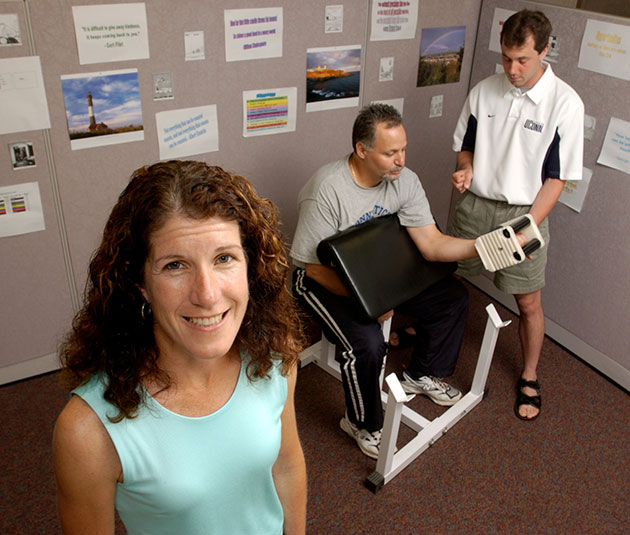
Linda Pescatello, Board of Trustees Distinguished Professor of Kinesiology and senior editor of the American College of Sports Medicine?s Guidelines for Exercise Testing and Prescription, ninth edition. (File photo)
A prescriptive handbook widely used in medicine, athletics, and fitness programs, was recently republished in its ninth edition, edited by UConn kinesiology professor Linda Pescatello.
The latest edition of the American College of Sports Medicine?s Guidelines for Exercise Testing and Prescription seeks to remove barriers that often delay or prevent healthy individuals from starting beneficial exercise programs.
The book is the most widely circulated set of exercise guidelines in the world, the ?international gold standard? for all professionals conducting exercise testing or exercise programs, says Pescatello, senior editor of the ninth edition, and also associate editor of the eighth edition, published in 2009.
Previous editions of the ACSM?s Guidelines recommended a medical examination and physician-administered exercise testing, or stress testing, as part of health screening prior to starting vigorous-intensity exercise for individuals at moderate risk of cardiovascular disease, in order to identify those at risk for a sudden adverse cardiac event during exercise.
The new edition of the Guidelines, presented by Pescatello at the ACSM?s Health Fitness Summit in Las Vegas in March and ACSM?s annual conference in Indianapolis in June, still recommends both a medical exam and physician-administered stress testing for individuals at high risk of, or with known, cardiovascular disease before they begin either a moderate or vigorous-intensity exercise program.
But the Guidelines no longer recommend these steps for individuals at moderate risk before they start a progressive exercise regimen, and no longer recommend stress testing for the same group before starting vigorous-intensity exercise.
The benefits of exercise far outweigh the risks.
ACSM?s Guidelines for Exercise Testing and Prescription is based on the most current evidence in the field, including ACSM position and statement stands, says Pescatello, UConn Board of Trustees Distinguished Professor of Kinesiology and a principal investigator at UConn?s Center for Health, Intervention, and Prevention (CHIP). She has focused her career on examining the connection between exercise and health.
?The updated guidelines for pre-participation health screening remove unnecessary and unproven barriers to starting an exercise program, and reinforce the public health message that the benefits of exercise far outweigh the risks,? she says. ?At the same time, the guidelines place a stronger need on identifying those clients with known disease, because they are at the highest risk for an exercise-related cardiac event.?
In place of previous emphasis on medical evaluation, the new pre-participation health screening guidelines place a greater emphasis on self-guided screening methods, encouraging all individuals who want to begin a physical activity program to complete a health risk appraisal questionnaire at a minimum, Pescatello said. The need for and degree of follow-up required can then be guided by the responses to the questionnaire.
?There are multiple considerations that have prompted these different points of emphasis,? Pescatello explains. ?The risk of a cardiovascular event is increased during vigorous-intensity exercise relative to rest, but the absolute risk of a cardiac event is low in healthy individuals. Recommending a medical examination and stress test as part of the pre-participation health screening process for all people at moderate to high risk prior to initiating a light- to moderate-intensity exercise program implies that being physically active confers greater risk than a sedentary lifestyle.?
Hartford Hospital cardiologist Dr. Paul Thompson, a research collaborator of Pescatello since 1998, served as associate editor of the new Guidelines and wrote the introductory chapter for the book emphasizing the safety and benefits of exercise. He also authored what Pescatello describes as the ?long overdue? second chapter, which contains the new pre-participation health screening recommendations.
Other new features of the ninth edition of the Guidelines include a new chapter about proven theory-based behavioral methods to increase adherence to exercise programs; more specific information about working with special populations, such as those who have had bariatric surgery or who have multiple chronic diseases and health conditions; and a new automated reference system that was developed by UConn medical librarian Jill Livingston.
Also for the first time for the ninth edition, Pescatello invited a clinical pharmacist ? UConn assistant clinical professor of pharmacy practice and CHIP affiliate, Thomas Buckley ? to prepare the appendix on commonly encountered medications among people that exercise.
Pescatello?s work on the ninth edition of the Guidelines began almost as soon as her work on the eighth edition ended.
?It is a professional honor to be selected as editor of the ACSM?s Guidelines for Exercise Testing and Prescription because of the significant impact they have on the work that we do in our field,? she says, ?and it is a labor of love.?
oosthuizen louis double eagle bubba masters winner instagram facebook chicago cubs split pea soup recipe
No comments:
Post a Comment